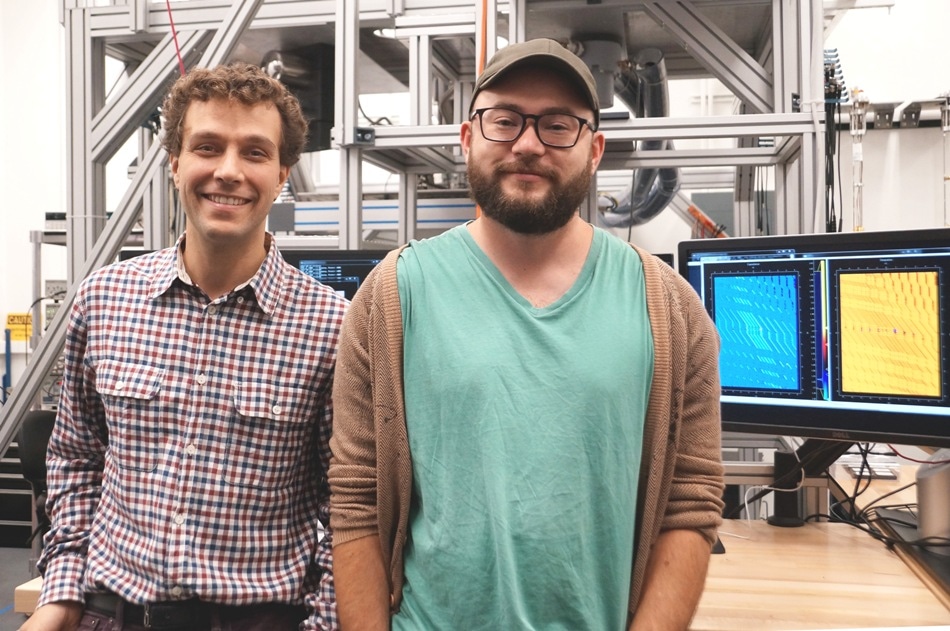Nov 7 2017
What kinds of ‘particles’ are allowed by nature? The answer lies in the theory of quantum mechanics, which describes the microscopic world.
 Researchers Andrea Young, left, and Sasha Zibrov (Credit: SONIA FERNANDEZ)
Researchers Andrea Young, left, and Sasha Zibrov (Credit: SONIA FERNANDEZ)
In a bid to stretch the boundaries of our understanding of the quantum world, UC Santa Barbara researchers have developed a device that could prove the existence of non-Abelian anyons, a quantum particle that has been mathematically predicted to exist in two-dimensional space, but so far not conclusively shown. The existence of these particles would pave the way toward major advances in topological quantum computing.
In a study that appears in the journal Nature, physicist Andrea Young, his graduate student Sasha Zibrov and their colleagues have taken a leap toward finding conclusive evidence for non-Abelian anyons. Using graphene, an atomically thin material derived from graphite (a form of carbon), they developed an extremely low-defect, highly tunable device in which non-Abelian anyons should be much more accessible.
First, a little background:
In our three-dimensional universe, elementary particles can be either fermions or bosons: think electrons (fermions) or the Higgs (a boson). “The difference between these two types of ‘quantum statistics’ is fundamental to how matter behaves,” Young said. For example, fermions cannot occupy the same quantum state, allowing us to push electrons around in semiconductors and preventing neutron stars from collapsing. Bosons can occupy the same state, leading to spectacular phenomena such as Bose-Einstein condensation and superconductivity, he explained. Combine a few fermions, such as the protons, neutrons, and electrons that make up atoms and you can get either type, but never evade the dichotomy.
In a two-dimensional universe, however, the laws of physics allow for a third possibility. Known as “anyons,” this type of quantum particle is neither a boson nor a fermion, but rather something completely different — and some kinds of anyons, known as non-Abelian anyons, retain a memory of their past states, encoding quantum information across long distances and forming the theoretical building blocks for topological quantum computers.
Although we don’t live in a two dimensional universe, when confined to a very thin sheet or slab of material, electrons do. In this case, anyons can emerge as “quasiparticles” from correlated states of many electrons. Perturbing such a system, say with an electrical potential, leads to the entire system rearranging just as if an anyon had moved.
The hunt for non-Abelian anyons begins by identifying the collective states that host them. “In fractional quantum Hall states — a type of collective electron state observed only in two dimensional samples at very high magnetic fields — the quasiparticles are known to have precisely a rational fraction of the electron charge, implying that they are anyons,” Young said.
“Mathematically, sure, non-Abelian statistics are allowed and even predicted for some fractional quantum Hall states.” he continued. However, scientists in this field have been limited by the fragility of the host states in the semiconductor material where they are typically studied. In these structures, the collective states themselves appear only at exceptionally low temperatures, rendering it doubly difficult to explore the unique quantum properties of individual anyons.
Graphene proves to be an ideal material to build devices to search for the elusive anyons. But, while scientists had been building graphene-based devices, other materials surrounding the graphene sheet — such as glass substrates and metallic gates — introduced enough disorder to destroy any signatures of non-Abelian states, Zibrov explained. The graphene is fine, it’s the environment that is the problem, he said.
The solution? More atomically thin material.
“We’ve finally reached a point where everything in the device is made out of two-dimensional single crystals,” said Young. “So not only the graphene itself, but the dielectrics are single crystals of hexagonal boron nitride that are flat and perfect and the gates are single crystals of graphite which are flat and perfect.” By aligning and stacking these flat and perfect crystals of material on top of each other, the team achieved not only a very low-disorder system, but one that is also extremely tunable.
“Besides realizing these states, we can tune microscopic parameters in a very well controlled way and understand what makes these states stable and what destabilizes them,” Young said. The fine degree of experimental control — and elimination of many unknowns— allowed the team to theoretically model the system with high accuracy, building confidence in their conclusions.
The materials advance gives these fragile excitations a certain amount of robustness, with the required temperatures nearly ten times higher than needed in other material systems. Bringing non-Abelian statistics into a more convenient temperature range proves an opportunity for not only for investigations of fundamental physics, but reignites hope for developing a topological quantum bit, which could form the basis for a new kind of quantum computer. Non-Abelian anyons are special in that they are thought to be able to process and store quantum information independent of many environmental effects, a major challenge in realizing quantum computers with traditional means.
But, say the physicists, first things first. Directly measuring the quantum properties of the emergent quasiparticles is very challenging, Zibrov explained. While some properties — such as fractional charge — have been definitively demonstrated, definitive proof of non-Abelian statistics — much less harnessing nonabelian anyons for quantum computation — has remained far out of the reach of experiments. “We don’t really know yet experimentally if non-Abelian anyons exist,” Zibrov said.
“Our experiments so far are consistent with theory, which tells us that some of the states we observed should be non-Abelian, but we still don’t have an experimental smoking gun.”
“We’d like an experiment that actually demonstrates a phenomenon unique to non-Abelian statistics,” said Young, who has won numerous awards for his work, including the National Science Foundation’s CAREER Award. “Now that we have a material that we understand really well, there are many ways to do this — we’ll see if nature cooperates!”